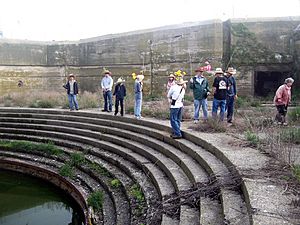Fort Michie facts for kids
Quick facts for kids Fort Michie |
|
|---|---|
| Part of Harbor Defenses of Long Island Sound | |
| Great Gull Island, Southold, New York | |
|
Location in New York
|
|
| Coordinates | 41°12′08″N 72°07′07″W / 41.20222°N 72.11861°W |
| Type | Coastal Defense |
| Site information | |
| Owner | American Museum of Natural History |
| Controlled by | private |
| Open to the public |
by appointment |
| Site history | |
| Built | 1897-1908 |
| Built by | United States Army |
| In use | 1900-1946 |
| Battles/wars | World War I World War II |
| Garrison information | |
| Garrison | 11th Coast Artillery Regiment |
Fort Michie was a special military base built by the United States Army. It was located on Great Gull Island in New York. Its main job was to protect the coast.
Fort Michie worked with other forts like Fort H. G. Wright and Fort Terry. Together, they guarded the eastern entrance to Long Island Sound. This helped protect important ports in Connecticut and the northern shore of Long Island.
The fort was named after First Lieutenant Dennis Michie. He was a brave soldier who died in the Spanish–American War. Dennis Michie is also famous for bringing American football to the United States Military Academy at West Point. The Michie Stadium there is named after him.
Fort Michie was built around the year 1900. It was used during World War I and World War II. After World War II, it was no longer needed as a fort. Since the 1950s, the island has been used by the American Museum of Natural History. They study migratory terns (a type of seabird) there.
Contents
Fort Michie's History
Building the Fort and Its Guns
Fort Michie was part of a big plan called the Endicott Program. This plan aimed to build strong new defenses along the coast. The United States Army Corps of Engineers designed and built the forts. The United States Army Ordnance Corps created the powerful weapons.
Construction of the gun batteries at Fort Michie began in 1897. By 1908, several batteries were ready. These included Battery Palmer with two 12-inch guns. Battery North had two 10-inch guns. There were also Batteries Benjamin and Maitland, each with two 6-inch guns. Battery Pasco had two smaller 3-inch guns. Many of these guns were on "disappearing carriages." This meant the gun would pop up to fire, then drop back down for protection.
Fort Michie During World War I
When the United States joined World War I in 1917, changes happened at the forts. The army wanted to send some coastal artillery weapons to the battlefields in Europe. In August 1917, the two 10-inch guns from Battery North were removed. The idea was to use them as railway guns (guns mounted on trains). However, these guns never left the island during the war.
Between the World Wars
After World War I, a new, very powerful weapon was created: the 16-inch gun. This was the strongest gun the United States had at the time. The first of these huge guns was placed at Fort Michie. It had a special carriage that allowed it to fire in all directions. This was the biggest gun setup ever built by the U.S. at that point. It was named Battery Davis. To make room for this new gun, Battery North was taken down.
Other changes happened at the fort too. In 1930, one of Battery Palmer's 12-inch guns was moved to Fort H. G. Wright. It was replaced by a similar gun the next year. In 1933, the two 3-inch guns from Battery Pasco were sent to Fort Mills in the Philippines. These guns were not replaced.
In 1938, a big storm called the 1938 New England hurricane hit the area. Many of the fort's buildings were destroyed. At this time, the fort likely had very few soldiers stationed there.
Fort Michie During World War II
In 1940, the United States looked at its coastal defenses again. Fort Michie was given a less important role. The fort was not well protected against air attacks. Even its big 16-inch gun had a shorter range compared to newer weapons.
Still, many temporary buildings were built in 1941. This was to house almost 500 soldiers. The main defense for Long Island Sound shifted to Camp Hero State Park in Montauk. Two batteries with two 16-inch guns each were built there. Another battery was planned for Fort H. G. Wright but was not finished.
By 1944, the new batteries at Camp Hero were complete. Because of this, Battery Davis (with the 16-inch gun) was taken out of service. Battery Palmer followed soon after. The only new battery built at Fort Michie during the war was AMTB 912 in 1943. This battery had four 90 mm guns. Some were fixed in place, and others could be moved.
After the Wars
In 1946, all the guns at Fort Michie were removed and scrapped. The fort was completely abandoned in 1948.
In 1949, the American Museum of Natural History bought the island. They use it to study migratory terns. This research continues to this day.



